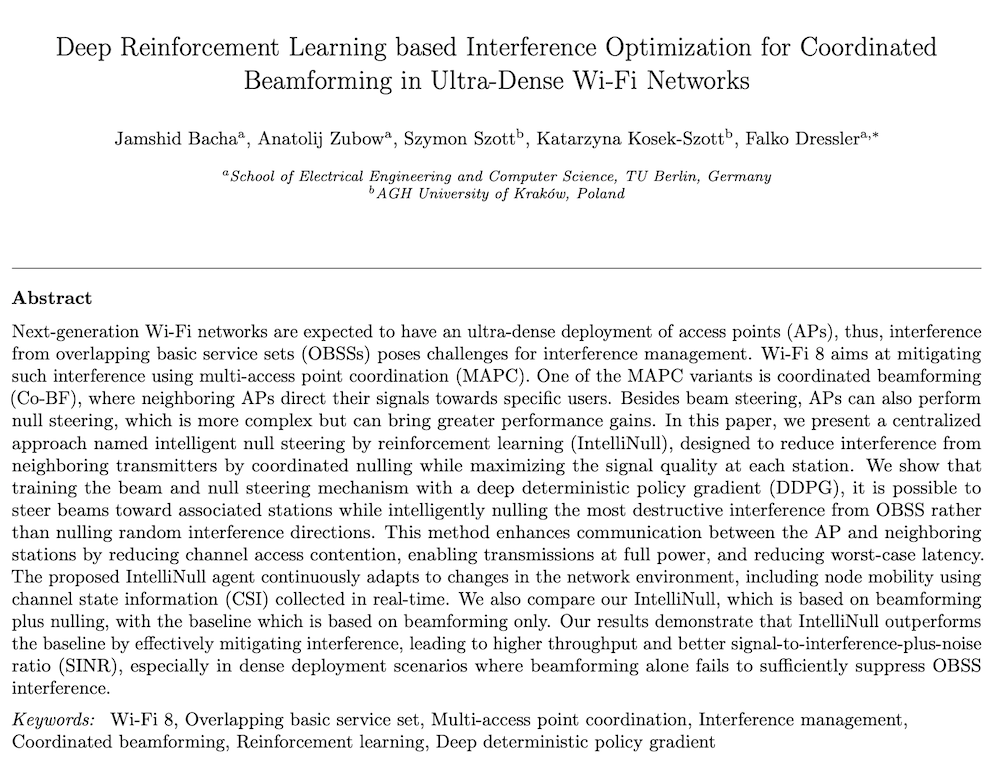Literature Database Entry
zubow2022ftm-ns3
Anatolij Zubow, Christos Laskos and Falko Dressler, "FTM-ns3: WiFi Fine Time Measurements for NS3," Proceedings of 17th IEEE/IFIP Conference on Wireless On demand Network Systems and Services (WONS 2022), Virtual Conference, March 2022, pp. 1–7.
Abstract
Wireless networks having location-awareness will foster new classes of applications. Here, a precise range estimation is of critical importance. The Fine Time Measurement (FTM) protocol introduced in IEEE 802.11-2016 uses radio frequency based time-of-flight estimation which enables precise indoor ranging and positioning. This paper presents FTM-ns3, an extension for the widely used ns3 network simulator to support the 802.11 FTM protocol. Using results from experiments with real FTM hardware, we developed error models to be used in simulations. These new error models allow to analyze the impact of channel bandwidth and Line of Sight (LOS) with multipath channel propagation on the performance of FTM-based localization schemes. First results from own simulations show that even a simple localization scheme is highly affected by ranging inaccuracy introduced due to multipath propagation in typical indoor environments even so a LOS component exists. Our extension is provided to the community as open source under a GPL license.
Quick access
Original Version ![]() (at publishers web site)
(at publishers web site)
Authors' Version ![]() (PDF on this web site)
(PDF on this web site)
BibTeX ![]()
Contact
Anatolij Zubow
Christos Laskos
Falko Dressler
BibTeX reference
@inproceedings{zubow2022ftm-ns3,
author = {Zubow, Anatolij and Laskos, Christos and Dressler, Falko},
doi = {10.23919/WONS54113.2022.9764460},
title = {{FTM-ns3: WiFi Fine Time Measurements for NS3}},
pages = {1--7},
publisher = {IEEE},
address = {Virtual Conference},
booktitle = {17th IEEE/IFIP Conference on Wireless On demand Network Systems and Services (WONS 2022)},
month = {3},
year = {2022},
}
Copyright notice
Links to final or draft versions of papers are presented here to ensure timely dissemination of scholarly and technical work. Copyright and all rights therein are retained by authors or by other copyright holders. All persons copying this information are expected to adhere to the terms and constraints invoked by each author's copyright. In most cases, these works may not be reposted or distributed for commercial purposes without the explicit permission of the copyright holder.
The following applies to all papers listed above that have IEEE copyrights: Personal use of this material is permitted. However, permission to reprint/republish this material for advertising or promotional purposes or for creating new collective works for resale or redistribution to servers or lists, or to reuse any copyrighted component of this work in other works must be obtained from the IEEE.
The following applies to all papers listed above that are in submission to IEEE conference/workshop proceedings or journals: This work has been submitted to the IEEE for possible publication. Copyright may be transferred without notice, after which this version may no longer be accessible.
The following applies to all papers listed above that have ACM copyrights: ACM COPYRIGHT NOTICE. Permission to make digital or hard copies of part or all of this work for personal or classroom use is granted without fee provided that copies are not made or distributed for profit or commercial advantage and that copies bear this notice and the full citation on the first page. Copyrights for components of this work owned by others than ACM must be honored. Abstracting with credit is permitted. To copy otherwise, to republish, to post on servers, or to redistribute to lists, requires prior specific permission and/or a fee. Request permissions from Publications Dept., ACM, Inc., fax +1 (212) 869-0481, or permissions@acm.org.
The following applies to all SpringerLink papers listed above that have Springer Science+Business Media copyrights: The original publication is available at www.springerlink.com.
This page was automatically generated using BibDB and bib2web.







